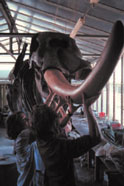
 |
||
 |
||
 |

- The Museum has fine collections of both vertebrate and invertebrate animal fossils that are used for study by our geologists and other scientists around the world.
- The Museum is known for its large collection of fossils of Ice Age animals.
- Our collection of plant fossils includes a large number of specimens from the Mazon Creek (use browser back button to return here) and Rock Island areas of Illinois. These fossils, which are about 300 million years old, help build a picture of our world as it appeared before its continents drifted apart.
- We also curate thousands of rock and mineral specimens.

- what the earth looked like thousands to millions of years ago
- what kinds of plants and animals lived here
- how the climate has changed.
Geologists who study plants and animals of the past are called paleontologists. We have two types of paleontologists at the Museum: paleozoologists who look at ancient animal fossils and paleobotanists who examine fossils of ancient plants. Both study organisms, how they interacted with each other and their environment, and how they are related to modern species of plants and animals.


Our paleontologists are especially interested in the Ice Age and the more recent period, which together span the last 2 million years. By analyzing remains found on field excavations and in our collections, they are trying to find out why animals, such as the mastodont, went extinct after the Ice Age, about 10,000 years ago.
Some of these paleontologists explore caves to search for evidence of ancient plants and small animals like mice, shrews, and bats. The sheltered conditions in caves help preserve their tiny remains. Small animals are very sensitive to environmental conditions and therefore provide good information about the climate in which they lived. They provide a record of environmental changes in Illinois.
Read about a museum geologist as he does cave research (use browser back button to return here) .
|
|
Copyright© 2000 Illinois State Museum Society